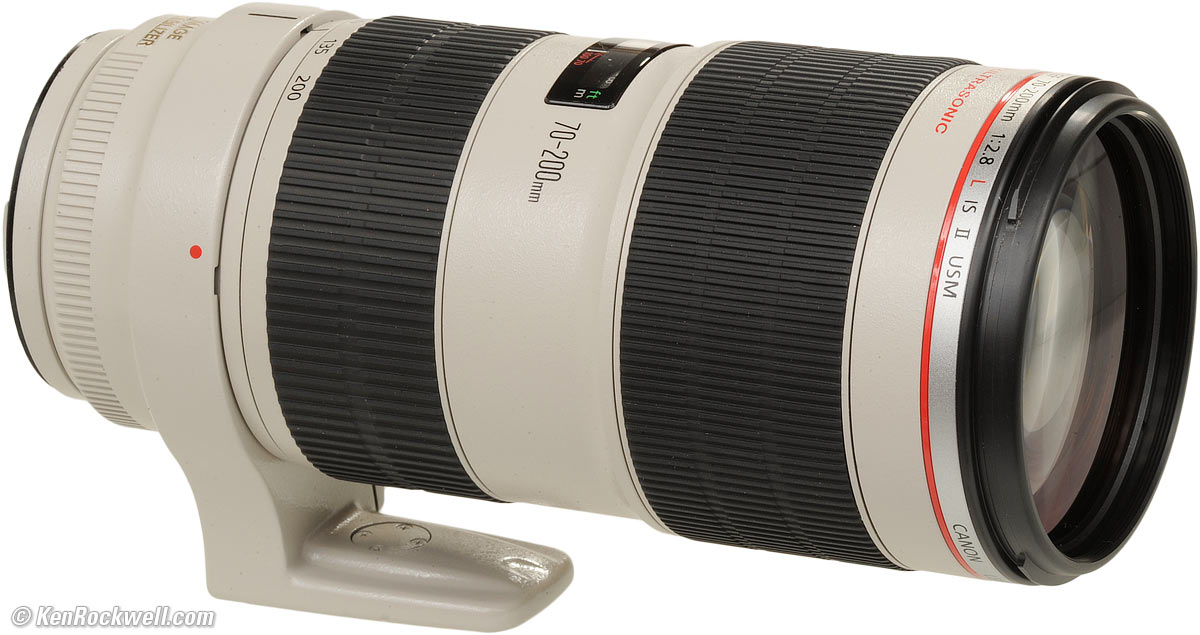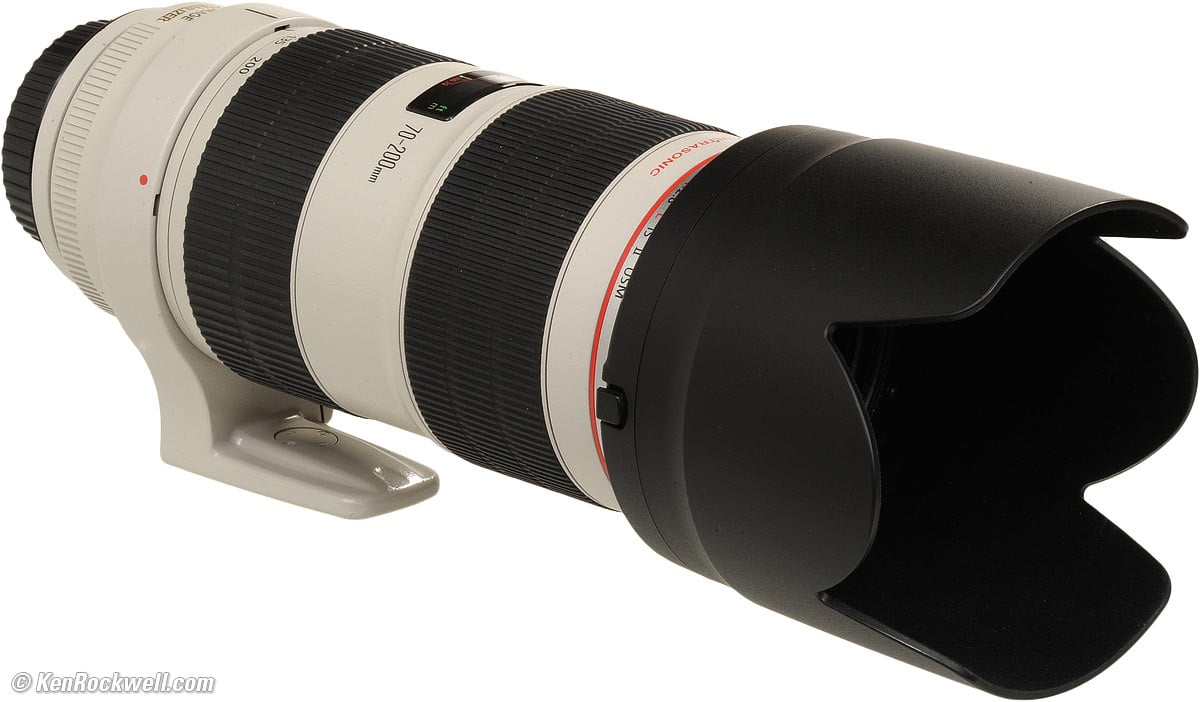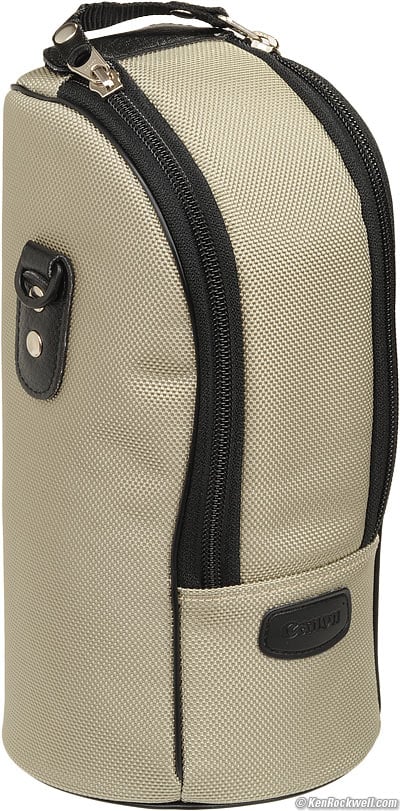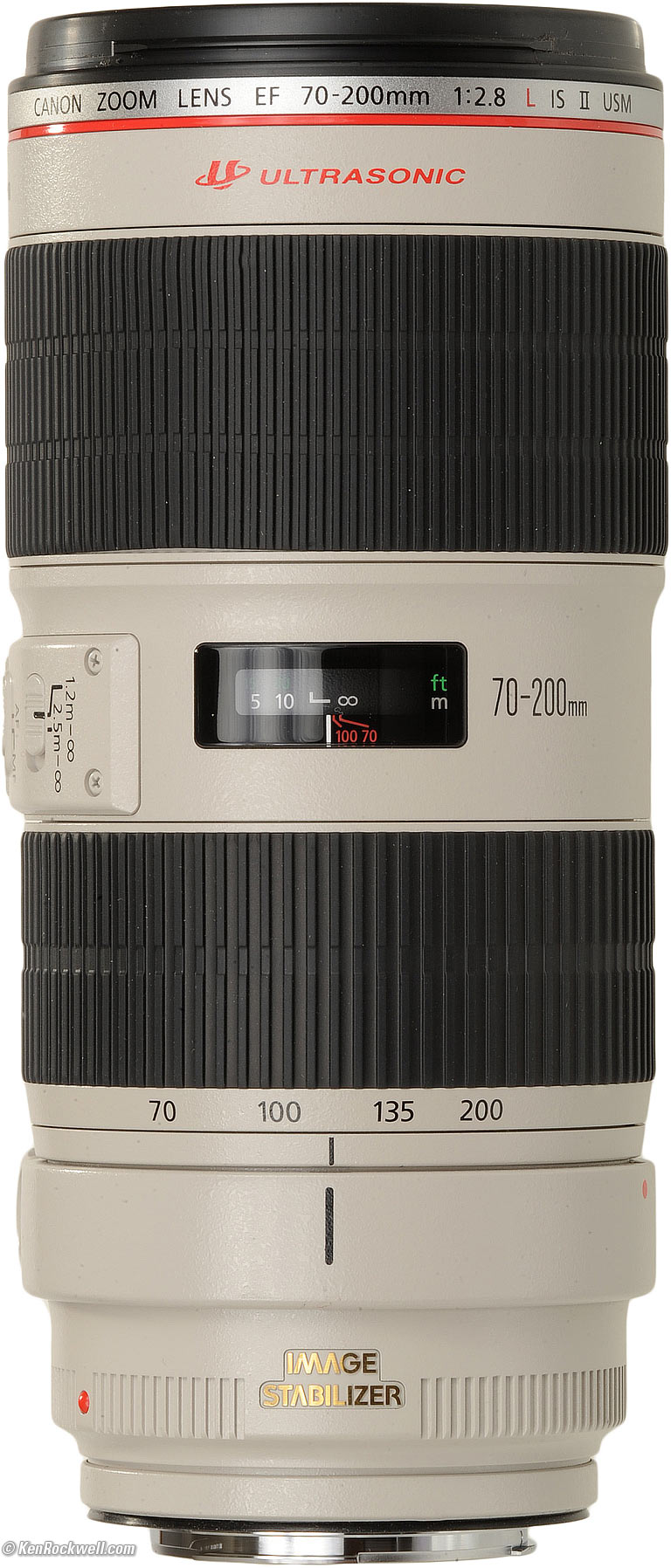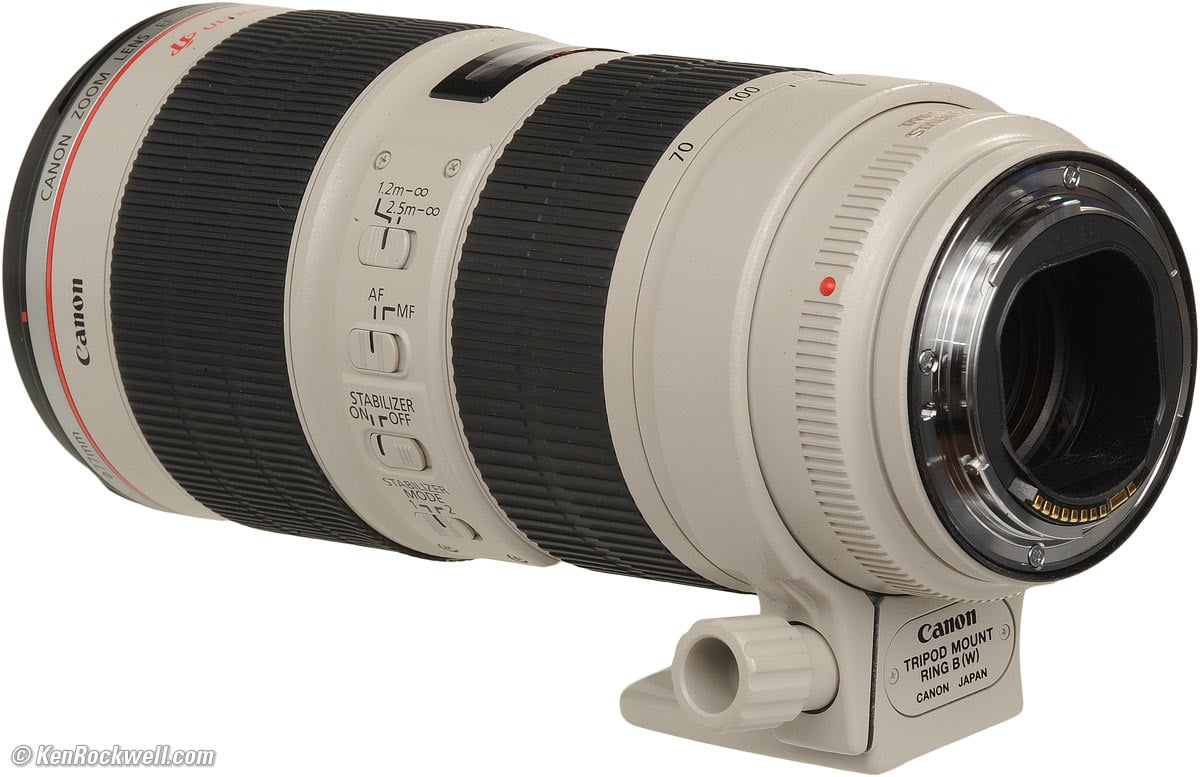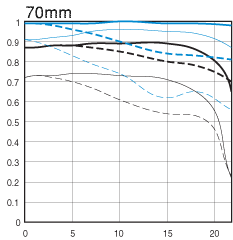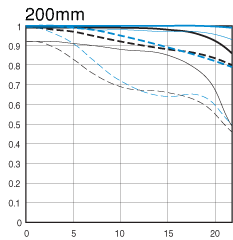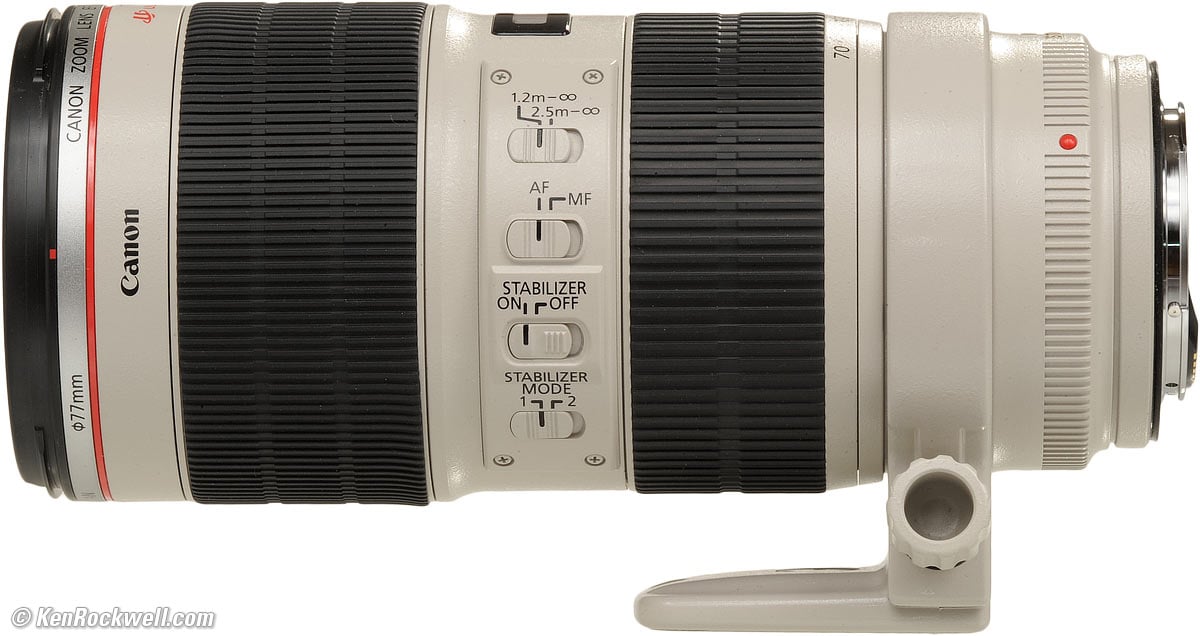Home Donate New Search Gallery Reviews How-To Books Links Workshops About Contact
Canon 70-200mm f2.8 IS II
Full-Frame EF L USM (2010-today)
Intro Specs Performance Compared Usage Recommendations
Canon EF 70-200mm f/2.8 L IS II USM (covers all formats, metal 77mm filter thread, 4 feet/1.2m close-focus, 52.4 oz./1,485g without collar, about $1,899.) enlarge. I got mine at Adorama. I'd also get it at Amazon, at B&H or at Crutchfield.
This all-content, junk-free website's biggest source of support is when you use those or any of these links to my personally-approved sources when you get anything, regardless of the country in which you live. Canon does not seal its boxes in any way, so never buy at retail or any other source not on my personally approved list since you'll have no way of knowing if you're missing accessories, getting a defective, damaged, returned, store demo or used camera. Buy only from the approved sources I use myself for the best prices, service, return policies and selection. Thanks for helping me help you! Ken.
Adorama pays top dollar for your used gear, especially the older model Canon EF 70-200mm f/2.8L IS USM.
https://www.adorama.com/CA702004ISU.html?kbid=21866
April 2018 Canon Reviews Canon Lenses All Reviews
NEW: Canon 100-400mm IS L II, which focuses closer and generally replaces this lens. I prefer the 100-400 II because it focuses closer than any 70-200 lens, f/4.5~5.6 is more than fast enough for shooting in any light with digital cameras (f/2.8 was for film), and I greatly prefer the 200~400mm range in exchange for losing the insignificant 70~100mm range. I wrote this review before the 100-400 II came out. The 100-400 II is also ultra sharp and has fantastic bokeh for portraits; focal length (400 versus 200mm) is more important for defocus than f/stop (f/5.6 vs. f/2.8).
See also:
Canon 70-200 Comparison Table.
Canon 70-200mm f/2.8L IS (2001-2010)
Canon 70-200mm f/2.8L (1995-)
Canon 80-200mm f/2.8L (1989-1995)
Canon 70-200mm f/4L IS (2006-)
Canon 70-200mm f/4L (1999-)
Introduction top
Intro Specs Performance Compared Usage Recommendations
|
I buy only from these approved sources. I can't vouch for ads below. |
The Canon EF 70-200mm f/2.8L IS II USM is astonishing. It really is the sharpest zoom I've ever tested. Heck, after shooting mostly LEICA for the past couple of years, I forgot that my 5D Mark II could make images this sharp. This was in 2011; today the new 100-400mm II has even higher MTF curves and is probably better still.
Not only is the 70-200/2.8 IS II sharp, it also has less distortion than any other 70-200mm zoom.
Not only is it sharper and has less distortion than any other tele zoom, it focuses almost instantly. It's scary: silently and without vibration, things magically just pop into focus.
As we expect, just grab the manual focus ring at any time for instant manual focus override.
It's also got Canon's fantastic Image Stabilization (IS), rated for four stops of improvement. You can leave the tripod at home.
No wonder this lens is in every pro's bag. For people, weddings, portraits, nature, landscape, and well, anything for which you need the best tele zoom you can get, this is the lens if you're a full-time pro. Long zooms are the lenses on which each maker stakes it reputation, and they therefore are the very best each maker can do. Canon has spared no expense in making this the best lens they can, and it shows.
For $2,400, Canon graciously throws in not only caps, but also the ET-87 hood and very nice LZ1326 zippered, padded case.
For more casual use, the Canon 70-200mm f/4 IS costs and weighs a lot less, but if you're counting every pixel or need even faster autofocus, this new lens really does live up to its price. It's astounding; it's the real deal.
This Canon EF 70-200mm f/2.8L IS II USM lens replaces the first Canon EF 70-200mm f/2.8L IS USM that was introduced in 2001.
Compatibility and Formats
This L lens is optimized for 35mm film and full-frame digital, and of course works on 1.3x and 1.6x Canon cameras.
This Canon EF EOS 70-200mm f/2.8L IS II works perfectly with every Canon EOS camera ever made, meaning every Canon DSLR and every Canon autofocus 35mm camera made since 1987.
This means of course it works great on today's 5D Mark II and Canon 7D, but it works just as well on my original Canon EOS 620 from 1987!
As a full-frame lens, this works on all Canon SLRs, regardless of format. As a professional lens, I will be reviewing this lens on full-frame.
Specifications top
Intro Specs Performance Compared Usage Recommendations
Name
Canon calls this the CANON ZOOM LENS EF 70-200mm f/2.8L IS II USM.
EF means "electronic focus," meaning that there is an autofocus motor in the lens itself. All Canon lenses since 1987 have been EF.
L only means as expensive as L; it means nothing technically.
IS is Image Stabilization, which makes tripod obsolete most of the time.
II means that this is the second Canon 70-200/2.8 IS. The earlier one was made from 2001-2010.
USM means Ultra-Sonic Motor. This means autofocus is almost silent, and that you can grab the big focus ring for instant manual focus override at any time.
Optics top
23 (!) elements in 19 (!) groups.
1 fluorite and 5 UD elements.
Internal focus and internal zoom; nothing moves externally as focused or zoomed.
Focal Length
70~200mm.
On 1.3x Canon cameras it will see angles-of-view similar to what a 90~260mm lens would see on a 35mm camera.
On 1.6x Canon cameras it will see angles-of-view similar to what a 115~320mm lens would see on a 35mm camera.
Angle of View (on 35mm and full-frame cameras)
34º ~ 12º diagonal.
19.5º ~ 7º vertical.
29º ~ 10º horizontal.
Close Focus top
4 feet (1.2m), specified, from the image plane.
Maximum Reproduction Ratio top
1:4.8.
Image Stabilization top
Rated for four stops (16 times) reduction in camera-shake induced image blur.
Teleconverters
This lens may be used with either of the Canon EF 1.4x II or Canon EF 2x II Teleconverters.
Extension Tubes
Use the Canon EF12 II to get close-ups to about one-quarter life-size at the image sensor.
Use the Canon EF25 II to get close-ups to about 4/10 life-size at the image sensor.
Close-up Lenses
Use the Canon 500D to get close-ups to about 6/10 life-size at the image sensor.
Diaphragm top
8 blades.
Stops down to f/32.
Reasonably round up to f/8, octagonal at f/11 ~ f/32.
Like most SLR lenses, it's never perfectly symmetrical at the smallest settings.
Hard Infinity Focus Stop? top
No.
You have to let the AF system focus for you at infinity.
Focus Scale top
Yes.
The ring turns from infinity to the closest focus distance in about 120.º
Depth-of-Field Scale top
No.
Infra-Red Focus Indices top
Yes, marks for 70mm and 100mm focal lengths.
These marks are for the 800 nm wavelength.
Filter Thread top
77mm.
Metal.
Does not move, ever.
Size top
Canon specifies 3.5" (88.8mm) diameter by 7.8" (199mm) long.
It doesn't change size as zoomed.
Weight top
52.385 oz. (1,485.2g), measured without tripod collar.
56.432 oz. (1,599.85g), measured with collar.
Canon specifies 52.6 oz. (1,490g).
Hood top
Canon EF 70-200mm f/2.8 L IS II USM with included ET-87 hood. enlarge.
$62 plastic bayonet ET-87, included.
Case top
Canon LZ1326 case, included.
$70 LZ1326 zippered, padded case, included.
It's nice: the dual zippers are connected, and if you pull them down, Velcro at the top can keep it closed.
Caps top
Standard 77mm ET-77U front, included.
Standard EOS cap rear.
Introduced top
05 January 2010.
Quality top
Made in Japan.
Price, USA top
$1,899, April 2018.
$1,949, October 2017.
$1,899, June 2017.
$1,999, Christmas 2015.
$2,200 after rebate, Christmas 2014.
$2,200 after rebate, May 2013.
$2,400, October 2011.
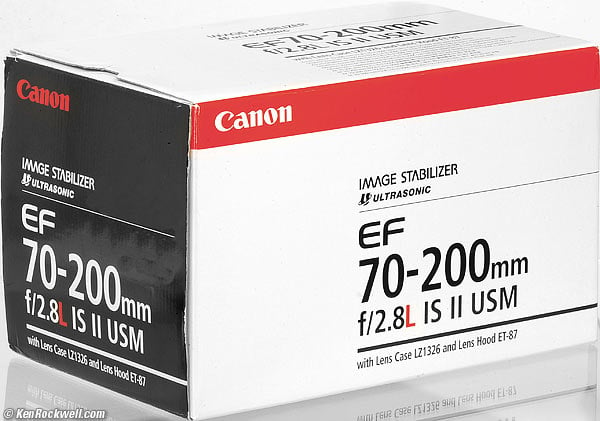
Box, Canon 70-200/2.8L IS II (7 x 7 x 12" / 185 x 185 x 300mm).
Performance top
Intro Specs Performance Compared Usage Recommendations
Overall Autofocus Bokeh Breathing Color Distortion
Ergonomics Falloff Filters Lateral Color Fringes
Mechanics Sharpness Spherochromatism Sunstars
Overall performance top
The Canon 70-200mm f/2.8 L IS II is optically and mechanically superb.
It's also big, heavy and expensive.
If you're a pro, you've already got one either in your bag, or on your wish list.
Autofocus performance top
Autofocus is fast and silent.
It always seems instantaneous.
Auto/Manual Switching
Just grab the focus ring at any time for instant manual-focus override.
Only move the AF-MF switch to MF if you want to disable the camera from auto focusing.
AF Speed
AF is fast!, as Canons always are.
It's actually faster than the 70-200mm f/4 IS L and many other Canon lenses.
The AF motor is silent. All you'll hear is some internal sliding.
AF Accuracy and Consistency
I saw no autofocus error on my Canon 5D Mark II.
Especially at f/2.8, all my shots are dead-on perfect at every focal length.
Yes!
Manual Focus
Manual focus is easy; just grab the ring at any time.
It takes only 120º to go from end-to-end of the focus scale.
Bokeh performance top
Bokeh, the quality of out-of-focus areas as opposed to the degree of defocus, is beautiful. Backgrounds just melt away, regardless of the zoom setting.
Focus Breathing performance top
Focus breathing (the image changing size as focused) is mostly of interest to cinematographers who don't want the image changing size ("breathing") as the lens is focused among different subjects.
The image from the Canon 70-200mm f/2.8 L always gets larger as focused more closely.
Color Rendition performance top
The color balance of this 70-200mm f/2.8 L IS II seems to match my other Canon EF lenses.
Distortion performance top
The Canon 70-200mm f/2.8 USM has less distortion than any other moderate tele zoom I've ever tested.
It's got some barrel distortion at 70mm and some pincushion distortion at 200mm, but never very much at any setting.For critical use, use these values in Photoshop's Lens Distortion tool to remove it:
at 10' (3m) |
||
70mm |
+1.5 |
+1.0 |
100mm |
0.0 |
0.0 |
135mm |
-1.0 |
0.0 |
200mm |
-1.5 |
0.0 |
© 2011 KenRockwell.com. All rights reserved.
Ergonomics performance top
Canon 70-200/2.8L II USM. enlarge.
This is a big, fat, heavy lens optimized for a man's hands.
The zoom and focus rings can be moved with one fingertip, but it takes some effort. They work much better if you can get your hand around them. The zoom feels as if it's working through a geartrain!
There are a lot more switches than just the AF-MF slider on the side. Canon has included various ridges so that you can differentiate them by feel.
Falloff (darkened corners) performance top
Falloff is visible at f/2.8 at the long end, and gone by f/4. It's not visible at the short end.
My Canon 5D Mark II (as of firmware 2.0.4) doesn't have the data to correct this automatically in its Peripheral Illumination Correction menu option. If you go find the data and load it into your camera (I'm too lazy), it should correct for this automatically.
I've greatly exaggerated this by shooting a flat gray target and presenting it against a gray background.
Canon 70-200mm f/2.8 L II falloff on full-frame No peripheral illumination correction
© 2011 KenRockwell.com. All rights reserved.
|
Filters, Use with performance top
Filters are easy.
The sturdy and precise metal threads don't move, and there isn't any problem with vignetting. Feel free to use thick rotating filters. There is no need for expensive "thin" polarizers.
Lateral Color Fringes performance top
There are no lateral color fringes as seen on my Canon 5D Mark II at 135mm and 200mm.
At 100mm there is a tiny bit of green/magenta color fringing.
At 70mm there is a little green/magenta color fringing.
Mechanics performance top
Rear, Canon 70-200 f/2.8 L. enlarge.
The Canon 70-200mm f/2.8 L IS II is quite different from Canon's usual plastic lenses in the under-$2,000 bin. This beast feels more like it comes from Canon's professional TV camera lens division: it's almost all metal and built like a tank.
Canon claims good dust and rain sealing, and I believe them. Sports pros shoot this out in the rain all the time, although you won't find me out there!
Filter Threads
Metal.
Hood Mount
Metal.
Identity Ring
Metal.
Fore Barrel
Plastic.
Focus Ring
Metal, rubber-covered.
Mid-barrel
Plastic.
Internals
Seem like metal.
Zoom Ring
Metal, rubber-covered.
Rear barrel
Metal.
Moisture seal at mount
Yes.
Mount
Chromed metal.
Markings
Paint.
Serial Number
Engraved into bottom of lens barrel and filled with black paint.
Date Code
Yes, hot-stamped into the rear light shield.
See Canon Date Codes to find your lens' birthday.
This sample is stamped UY0100, meaning January 2010.
Noises When Shaken
Moderately loud rattling and clunking.
Made in
Japan.
Sharpness performance top
As shot on the 5D Mark II under test conditions at infinity, the Canon 70-200mm f/2.8 L IS II is the sharpest zoom I've ever tested, especially at f/2.8.
The sharpness of the 70-200mm f/2.8 L IS II doesn't vary much except from diffraction at f/11 and smaller. It's just as sharp and contrasty at f/2.8 in the center as it is at f/8.
The biggest detriments to sharpness will be camera shake, subject motion and heat shimmer.
Here are Canon's claimed MTF curves, which agree with what I see:
Canon's MTF Curves.
Spherochromatism performance top
I see no spherochromatism
Spherochromatism, misnamed "color bokeh" by laymen, is when out-of-focus highlights take on color fringes. The Canon 70-200/2.8L's out-of-focus highlights have no color fringes.
Spherochromatism is a completely different aberration from lateral color fringes.
Sunstars performance top
With its mostly rounded 8-bladed diaphragm, this Canon 70-200mm f/2.8L IS II shouldn't make much in the way of sunstars at most apertures. At the smallest apertures, expect boring Canon-standard 8-pointed sunstars on brilliant points of light.
Compared top
Intro Specs Performance Compared Usage Recommendations
This 70-200mm is the choice of the pros because of its superior mechanics, instant autofocus, fast f/2.8 speed and of course ultra sharpness at every setting.
New: Best 70-200mm f/2.8 Lenses Compared 22 April 2018
Versus the 70-200/4 IS
It's so sharp that it's sharper at f/2.8 than the 70-200/4 IS is at f/4.
The 70-200/4 IS is popular with lazy people like me who don't want to carry this huge f/2.8 beast, but for the people willing to carry it, it's sharper, tougher, has less distortion and is faster to focus than the 70-200/4 IS.
Versus the previous 70-200/2.8L IS
This new II lens focuses more closely, along with 10 years of other optical innovations. If you already own the previous lens, nothing is forcing you to own the best, but you should.
See Is It Worth It.
Canon 70-200mm Comparison Table top
| Anni | 2010- |
2001-2010 |
1995- |
2006- |
1999- |
1989-1995 |
| Max. Aperture | f/2.8 |
f/2.8 |
f/2.8 |
f/4 |
f/4 |
f/2.8 |
| Stabilization | IS |
IS |
none |
IS |
none |
none |
| Close focus | 4'/1.2m |
4.6'/1.4m |
5'/1.5m |
4'/1.2m |
4'/1.2m |
5.9'/1.8m |
| Filter | 77mm |
77mm |
77mm |
67mm |
67mm |
72mm |
| Filter Threads | Metal |
Metal |
Metal |
plastic |
plastic |
Metal |
| Zoom Feel | Slow and damped |
Slow and damped |
Slow and damped |
A fast flick |
Fast |
A fast flick |
| Sharpness | Extreme |
Very good |
Excellent |
Excellent |
Very good |
Excellent |
| Distortion (W~T) | ||||||
| Materials | Mostly metal |
Mostly metal |
Mostly metal |
Metal and plastic |
Metal and plastic |
All Metal |
| Hood | Clumsy, but tough, bayonet |
Clumsy, but tough, bayonet |
Clumsy, but tough, bayonet |
Clumsy, but tough, bayonet |
Clumsy, but tough, bayonet |
Convenient, but lighter, snap-on |
| Tripod collar ergonomics | Clumsy |
Clumsy |
Clumsy |
optional |
optional |
Brilliant! |
| Weight w/collar if included | 1,600g |
1,471g |
1,370g |
756g |
711g |
1,412g |
| Price, 11/2011 | $1,600 used |
$750 used |
||||
| Price, 4/2012 | $1,700 used |
$760 used |
||||
| Price, 4/2018 | $900 used |
$460 used |
||||
| Best for | Full-time pros. |
Pros on a budget. |
Tripod use, action and sports pros. |
Nature and landscape shots in the field without tripod. |
Budget tripod, sports or family shooters demanding high quality. |
Tripod use, action and sports pros. |
Usage top
Intro Specs Performance Compared Usage Recommendations
Canon 70-200/2.8 IS L II. bigger.
Focus Limiter (top switch)
Leave it in the "1.2m ~ ∞" position.
The "2.5m ~ ∞" position prevents the lens from focusing any closer than 2.5 meters (8 feet). You might use this if you're shooting action at a distance and the lens is wasting time trying to focus this close and back looking for things.
AF - MF Switch
Leave this in AF. Just grab the focus ring at any time for instant manual-focus override.
Only set it to MF if you want it to be locked into manual focus.
Image Stabilizer
Leave this on. It eliminates camera shake for sharper pictures. It replaces a tripod, except indoors or at night.
The stabilizer works even when using a monopod.
The only time to turn it off is if you're on a very sturdy tripod.
The stabilizer even works with the Canon EF 1.4x II and Canon EF 2x II teleconverters, and the Canon EF12 II and Canon EF25 II extension tubes.
Stabilizer Mode
Presuming you have the Stabilizer ON:
Mode 1 is the usual mode. It lets the stabilizer to do the best job of keeping the picture sharp. It lets the stabilizer work in all directions.
Mode 2 is only for panning shots where you want a motion-blurred background. It disables the stabilizer from working in the direction in which you are panning.
Tripod Collar
Use this only if you're using a monopod. With Image Stabilization, you don't need a tripod.
I'd loosen the collar's knob, rotate the collar, pull it off towards the rear of the lens, and leave it in the box.
Recommendations top
Intro Specs Performance Compared Usage Recommendations
As of 2015, I prefer the Canon 100-400mm IS L II because it has more reach and it focuses more closely.
As of 2011 when I wrote most of this review before the 100-400 II came out, the Canon 70-200mm f/2.8L IS II was a favorite lens of thousands of professional photographers because of its fabulous optics, instant autofocus and tough mechanics.
It's heavy and expensive. Its performance and durability are what earn it a spot in most pro's bags. There is no better zoom for your Canon.
Personally, as an outdoor nature and landscape shooter, I'm too lazy to want to haul this beast around the woods with me. I own the 70-200mm f/4 IS for when I want a zoom, and use the EF 100mm f/2 for when I can forgo a zoom and want fantastic optics in an even smaller package.
This 70-200/2.8 II is for very serious photographers and full-time pros who will be spending more time shooting with this lens than carrying it around their necks.
Seeing how Amazon's customer reviews are also nearly 100% 5-stars, it's not just me who loves this 70-200/2.8 II. Everyone does!
If you've found the time I've spent sharing this professional review helpful, this free website's biggest source of support is when you use these links, especially these directly to it at Adorama or at Amazon, when you get anything, regardless of the country in which you live.
Thanks!
Ken.
More Information:
Canon's 70-200/2.8 L II Instruction Manual.
Help me help you top
I support my growing family through this website, as crazy as it might seem.
The biggest help is when you use any of these links when you get anything, regardless of the country in which you live. It costs you nothing, and is this site's, and thus my family's, biggest source of support. These places have the best prices and service, which is why I've used them since before this website existed. I recommend them all personally.
If you find this page as helpful as a book you might have had to buy or a workshop you may have had to take, feel free to help me continue helping everyone.
If you've gotten your gear through one of my links or helped otherwise, you're family. It's great people like you who allow me to keep adding to this site full-time. Thanks!
If you haven't helped yet, please do, and consider helping me with a gift of $5.00.
As this page is copyrighted and formally registered, it is unlawful to make copies, especially in the form of printouts for personal use. If you wish to make a printout for personal use, you are granted one-time permission only if you PayPal me $5.00 per printout or part thereof. Thank you!
Thanks for reading!
Mr. & Mrs. Ken Rockwell, Ryan and Katie.
Home Donate New Search Gallery Reviews How-To Books Links Workshops About Contact

